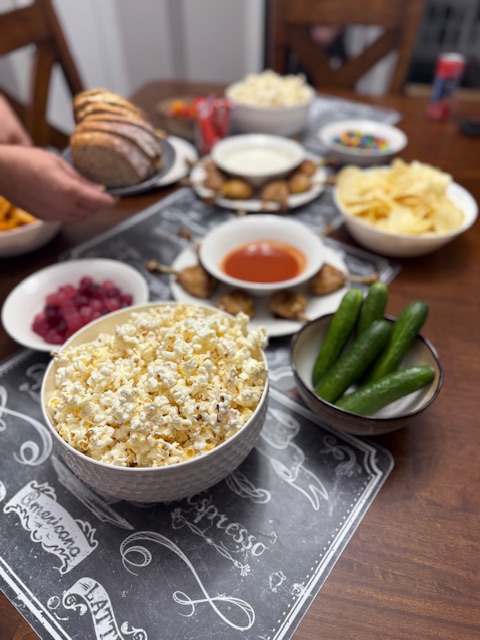Introduction
In today’s fast-paced world, maintaining a healthy family diet can feel overwhelming. With busy schedules, picky eaters, and the temptation of fast food, ensuring that your family gets nutritious meals might seem like a challenge. However, with a little planning and a few smart strategies, you can make healthy eating simple, fun, and sustainable. In this blog post, we’ll explore easy ways to improve your family’s nutrition, create balanced meals, and build lifelong healthy eating habits.
Why Family Meals Matter
You’ve probably noticed that food is at the heart of many of life’s important moments. Meals bring people together—whether it’s celebrating an occasion, bonding over a casual dinner, or sealing a business deal. But why should we only enjoy these meaningful meals at restaurants? Bringing nutritious meals to the family table at home can create stronger bonds, promote healthier eating habits, and even save money.
Studies show that families who eat together at home tend to consume more fruits, vegetables, and whole foods, while also reducing their intake of unhealthy, processed foods. Eating together fosters communication, reduces stress, and helps children develop a positive relationship with food.
Smart Grocery Shopping for a Healthier Family
One of the biggest steps toward better family nutrition is making informed choices at the grocery store. Here’s how you can shop smarter:
1. Plan Your Meals Ahead
Before heading to the store, create a weekly meal plan and a shopping list. Planning meals ensures that you buy only what you need, reducing waste and unnecessary spending. It also helps prevent last-minute unhealthy food choices.
2. Read Nutrition Labels
Ever really looked at Nutrition Facts labels? If you haven’t, now is the time! Compare products and choose options with shorter ingredient lists, fewer artificial additives, and lower amounts of sugar and sodium.
3. Choose Whole Foods Over Processed Foods
Stick to the outer aisles of the grocery store where fresh produce, lean proteins, and dairy products are usually found. Limit highly processed foods that contain artificial preservatives and excessive sugars.
4. Involve Your Kids in Grocery Shopping
Turn grocery shopping into a fun activity! Give your kids a small shopping list or let them choose a new vegetable to try. This involvement increases their curiosity and willingness to eat healthier foods.
Easy and Nutritious Home-Cooked Meals
Cooking at home is one of the best ways to ensure your family eats healthy, balanced meals. Here are some easy meal ideas to keep your family well-nourished:
Breakfast: The Most Important Meal of the Day
- Greek yogurt with granola and fresh berries
- Whole-grain toast with peanut butter and banana slices
- Scrambled eggs with spinach and whole-grain tortillas
Lunch: Quick and Healthy Options
- Grilled chicken and veggie wraps with hummus
- Lentil soup with whole-grain crackers
- Homemade tuna salad with leafy greens and avocado
Dinner: Balanced and Family-Friendly
- Stir-fried vegetables with brown rice and lean protein
- Oven-baked salmon with quinoa and steamed broccoli
- Whole-wheat pasta with tomato sauce, turkey meatballs, and fresh basil
Healthy Snacks for the Whole Family
- Hummus with sliced cucumbers and carrots
- Mixed nuts and dried fruit (no added sugar)
- Apple slices with almond butter
- Popcorn with nutritional yeast for a cheesy flavor
Hydration: Teach Your Family to Drink Smart
One of the biggest culprits of hidden sugar consumption is sweetened beverages. Many store-bought juices, sodas, and flavored drinks contain high amounts of added sugars, which contribute to weight gain and poor metabolic health.
Encourage Healthy Beverage Choices
- Teach kids that juice, soda, and sports drinks are treats rather than everyday drinks.
- Offer infused water (add slices of lemon, cucumber, or frozen berries for natural flavor).
- Serve unsweetened milk or plant-based alternatives for a calcium boost.
- Keep a water bottle with you at all times to make hydration a habit.
Pack Lunches & Snack Smart
Packing your own lunch is one of the best ways to avoid ultra-processed foods and control portion sizes. It also helps you save money while ensuring that you and your kids eat balanced meals throughout the day.
Lunchbox Ideas for Kids and Adults
- Turkey and avocado wraps with whole-wheat tortillas
- Hard-boiled eggs with whole-grain crackers and a side of fruit
- Homemade veggie and cheese quesadillas
- Brown rice with grilled shrimp and roasted vegetables
Snack Smarter
- Swap potato chips for homemade kale chips
- Replace candy bars with dark chocolate and nuts
- Try Greek yogurt with a drizzle of honey and chia seeds
- Opt for homemade protein balls made with oats, nut butter, and dates
Meatless Meals & Whole Grains
Eating more plant-based meals is a great way to increase fiber intake, reduce cholesterol, and improve overall health. Try incorporating at least one meatless meal per week into your family’s diet.
Simple Meatless Meal Ideas
- Chickpea and spinach curry with basmati rice
- Black bean and quinoa tacos
- Lentil soup with whole-grain bread
- Grilled vegetable and hummus wraps
Whole grains are also a must for a balanced diet. Swap out refined grains for whole-grain alternatives:
- White bread → Whole-grain bread
- White rice → Brown rice or quinoa
- Regular pasta → Whole-wheat or lentil pasta
- Sugary cereal → Oatmeal with fruit
Grow Your Own Food: A Fun and Educational Activity
Starting a small home garden is a fantastic way to teach kids about where food comes from. Even if you don’t have space for a full garden, growing a few herbs like basil, mint, or chives can be a fun and rewarding experience.
Benefits of Growing Your Own Food
- Encourages kids to eat more vegetables
- Provides fresh, organic produce at home
- Teaches responsibility and patience
- Makes meals more exciting when kids can add homegrown ingredients
Final Thoughts: You Are Your Kids’ Best Role Model
When it comes to family nutrition, remember that kids learn by example. If they see you enjoying a variety of healthy foods, drinking water instead of soda, and cooking at home, they are more likely to adopt these habits as well.
To summarize: ✅ Plan meals and shop smart ✅ Cook more at home and eat together as a family ✅ Read labels and choose whole foods over processed options ✅ Encourage smart hydration choices ✅ Pack lunches and choose healthier snacks ✅ Serve a meatless meal at least once a week ✅ Grow your own herbs or vegetables
Making small, sustainable changes will lead to long-term healthy eating habits for your entire family. Start today and watch your family thrive with better nutrition, more energy, and stronger bonds!

